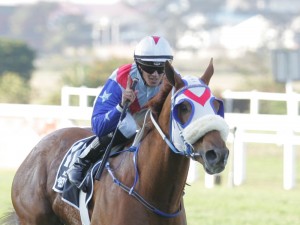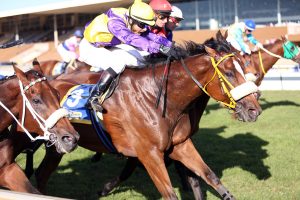Muscatt, Inara riders upbeat
PUBLISHED: April 26, 2016
Riders of Muscatt and Inara give their respective mounts the thumbs up…
The riders of both WSB Computaform Sprint participant Muscatt and Premier’s Champions Challenge runner Inara gave the thumbs up for their mounts at Summerveld yesterday.
Trainer Michael Roberts has remained loyal to Muscatt’s rider Calvin Habib, despite him still being a 2,5 kg claimer. Habib has hit form at just the right time and was superb when scoring a double at Greyville on Friday night and adding another winner at Scottsville on Sunday. He has ridden Muscatt in both of the six-year-old Victory Moon gelding’s last two outings, which have yielded two wins over 1000m at Scottsville, including a course record-breaking effort.
Habib was pleased with Muscatt’s pace work yesterday and said, “He doesn’t ever feel like he’s going fast and it’s only when you watch the race later that you see he is.” Roberts backed this up and it points to the gelding’s high cruising speed, an essential asset for a big field Gr 1 WFA Sprint like the Computaform. He has a decent kick too. His low draw might be a concern if last year’s race is anything to go by, although it was wet that day and the opposite is forecast to be the case on Saturday.
“The filly (Carry On Alice) will be hard to beat,” said Roberts. Muscatt will likely travel on Thursday, in the day if it’s not too hot, otherwise at night.
Grant Van Niekerk had no concerns at all about Inara staying the 2000m trip of the Premier’s Champions Challenge and was hopeful she could win. He feared Legal Eagle the most.
The Trippi filly has never faced the boys before but has the beating of Legal Eagle on a strict line through Smart Call. Furthermore, she jumps from a plum draw of two. She travelled well both there and back when winning the Gr Laurie Jaffee Empress Club Stakes on April 16 and should do so again. Van Niekerk concluded by saying Inara was “definitely” a Vodacom Durban July contender too.
By David Thiselton
No Worries enjoying the extra
PUBLISHED: April 26, 2016
Gold Cup on the cards for No Worries?
The Gavin Van Zyl-trained No Worries has come out of his win in the Highland Night Cup over 2400m at Scottsville on Sunday well.
Stable jockey Warren Kennedy said he had always been a good horse who was just a few lengths off the best, so a staying campaign would suit him because firstly the competition was not as strong and secondly he had proven his liking for the trip on Sunday by winning going away despite carrying joint topweight of 61,5kg.
“It is just nice to have him back to himself and the win might bring renewed confidence,” added Kennedy.
It was only the second time the six-year-old Summerhill-bred Kahal gelding had attempted the trip. The eLan Property Group Gold Cup looks to be on the cards.
By David Thiselton
Crawford camp confident
PUBLISHED: April 26, 2016
Be sure to follow Black Tractor…
Barry Donnelly, assistant to stalwart Cape trainer Brett Crawford, makes Black Tractor a big runner at Scottsville on Wednesday, where he faces a decent field in a MR 80 handicap over 1200m.
A couple of Crawford’s SA Champions Season charges might also be appearing at Scottsville on Sunday and among them is Gr 1 Betting World Cape Flying Championship winner Gulf Storm. Donnelly said about three-year-old Captain Al gelding Black Tractor, “He ran fourth at Scottsville in his pipe opener but was very green. He has been putting in exceptional work and has Anton Marcus up.”
Gulf Storm will be defending his Listed In Full Flight Handicap crown, which he won in his KZN pipe opener last season. However, if he does take his place he will have to lug 65kg off his 113 merit rating, as opposed to the 57kg he carried off a 100 merit rating last year. Donnelly said the five-year-old Sail From Seattle gelding, who has consistently defied the handicapper, had been doing very well. His chief mission is the Gr 1 Tsogo Sun Sprint, in which he was runner up last year.
The yard’s Gr 3 Prix du Cap winner and Gr 2 Southern Cross Stakes runner up Cuvee Brut will be facing a strong field in the Gr 3 Poinsettia Stakes on Sunday with Marcus up. She enjoys Summerveld and is doing “very well.”
Wavin’ Flag is back from a tendon injury, which saw him box rested for a long time, and will bid to repeat his win of the 2014 Gold Cup.
Alexis “blossoms” in Durban and this KRA Fillies Guineas winner should give a good account of herself again this Champions Season.
The expensively purchased Nebula has been gelded after his disappointing run in the Investec Cape Derby, but disappointed in his KZN debut over 1600m at Greyville last week where he had been expected to win, so now might not make it into the Gr 2 Canon Guineas field.
Sail South, Big Cat, Winter Prince, Red Moon At Night and Speedy Chestnut are the others in the Summerveld string at present.
By David Thiselton
Handicapping tweaks
PUBLISHED: April 26, 2016
New handicapping changes have made it difficult for handicappers…
The new handicapping changes have further reduced the handicapper’s ability to handicap purely and points to the difficulty in applying the merit rating system in a country with a relatively small thoroughbred population.
In England trainers find it relatively easy to keep the brilliant, the good and the mediocre apart virtually from day one of their careers and can plan their careers accordingly.
In South Africa trainers have far less options and horses of varying ability will be clashing from day one.
Consequently, the merit rating system looks on evidence to have been unfair on decent horses precocious and sound enough to have been able to make their debuts early.
As an example, two horses with exactly the same innate ability, three-year-old “Horse A” and four-year-old “Horse B”, win two separate maidens at a major course over 1600m in the month of October.
If Horse A won by a length, Horse B, if facing the exact same strength of field, would have to win its race by 6,5 lengths to perform to the same level, because three-year-olds will only be receiving 2kg from four-year-olds whereas in a weight for age event at that time of year they would be receiving 7,5kg.
However, jockeys riding a favourite set out to have enough fuel in the tank in the final stages merely to win, so Horse B duly wins by only a length, albeit comfortably.
Based on the pure result, Horse “A” will be merit rated eleven points higher than horse “B” and if they faced each other in a handicap next time out they would run at level weights despite having the same ability and a weight for age difference of 5,5kg.
Horse “A” therefore has a problem, especially considering the lack of three-year-old handicaps in SA. It might end up battling and by the time it gets down to a competitive mark its heart might have been broken. The owners will be similarly demoralised, especially considering the trainer had told them they had a nice horse.
The above analogy might explain why there are a myriad examples since the merit rating system was introduced in SA in the late 1990s of young horses winning early in their careers and then never winning again.
Looking at results from October 2007, at which stage the system had less restrictions imposed upon it than it now does, two examples can be found from the first two major centre meetings of the month.
Electrocase won a maiden third time out, was accorded an 84 merit rating and did not earn one more cent in eleven further races; Master’s Edge won on debut, was given an 82 merit rating and took a further ten races to land his first post maiden place.
The latest measures to address this issue are contained in the handicapper no longer being allowed to use a “special circumstances” clause to rate a three-year-old maiden winner higher than the benchmark nett 78 in a major centre. Furthermore, general principles are to be applied to horses not making the anticipated WFA improvement within 2 and 3 runs respectively.
At the other end of the scale, a clause whereby three-year-old maiden winners in a major centre cannot have a MR of less than a nett 64, provided the maiden win takes place within the first 8 starts, prevents young maiden winners from being handicapped too leniently.
Another problem in South Africa is the lack of horses filling the gap between the best horses and the low grade handicappers.
This manifests in some horses being left in “no man’s land”.
There are a lack of high grade handicaps for horses who are just below the best, so they have little choice but to compete against the best. When they are then handicapped against the best they are left in an even worse situation.
The latest changes will reportedly be accompanied by new measures to improve the programming of races, which might help the above band of horses.
Furthermore, there are also various new restrictions placed on penalising placed horses in Gr 2 and Gr 3 races as well as winners and runner ups in Listed races. Also, line horses can’t be further back than fourth in Gr 2 and Gr 3 races and fifth in Gr 1 races (they can’t be further back than third in minor handicaps and Listed races).
Another new clause is “Where a horse (especially an older horse) runs out of sync to its normal profile, the Handicappers should rather err on the side of caution and impose half the normal penalty and let the said horse prove the higher rating at its subsequent start.”
An extreme recent example could perhaps be provided by the three-year-old Le Clos.
Being owned by one of the country’s leading owners this horse could afford to be risked in a Gr 3 on the Turffontein Inside track after running above his merit rating in a Progress Plate.
The latter track is tight and can yield some odd results if the pace is false and when Le Clos ran third off his 74 merit rating beating 107 merit rated New Predator at level weights by three lengths, the alarm bells were ringing.
He was raised 25 points to a 99 merit rating and in three subsequent events in a Gr 2, a Gr 1 and a Progress Plate respectively has proven to not be up to the mark.
The new changes have been criticised by some of the best unofficial handicappers in the country and by some of the best punters.
It is admirable of the latter to voice their opinion as the more restrictions in place the better the edge they will have over the rest of the more ignorant betting population. However, only time will tell if they new changes bring some stability.
Trainers will help the situation by adapting to the system as some still appear to be stuck in the race figure system of the distant past.
By David Thiselton
Anthony fancies Zadora
PUBLISHED: April 26, 2016
Keep an eye out for Zadora…
The Scottsville meeting tomorrow starts with an interesting maiden juvenile plate over 1200m for fillies and the Dennis Drier-trained Sail is the one to beat on form, but Greg Anthony believes his yard will go close with Zadora and there are a number of decently bred first-timers taking their place.
Zadora is a big and strongly built daughter of Global One.
This impressive specimen was green on debut over 100m but caught the eye and the form has worked out fairly well. She will appreciate the step up in trip.
She will have her work cut out to beat Sail, who was also green but eyecatching when second on debut over 1200m and the form has worked out quite well there too.
The first-timers who have eyecatching pedigrees are all of Andermatt, Danish Cross, Lunar Rush, Onesie and Oroblanco.
By David Thiselton











